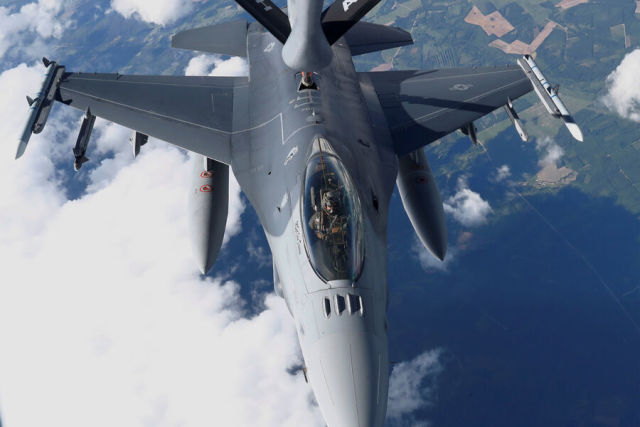Ex-Colonel of the General Staff Khodarenok: The West does not want to supply the AFU with aircraft and armored vehicles
The countries of Europe and the United States cannot agree on a single strategy for supplying weapons to Kiev. Military observer of the Newspaper.En" Mikhail Khodarenok figured out why the Armed Forces of Ukraine cannot get the equipment they are asking for from NATO.
Among the European leaders, the correspondence discussion on the supply of weapons and military equipment to the Armed Forces of Ukraine has intensified again.
German Chancellor Olaf Scholz said that supplies "with the same intensity as the United States" are impossible for Berlin, and Czech President Milos Zeman, on the contrary, argues that supplies "need to be increased." At the same time, in Kiev itself, they regularly complain that they do not receive the necessary weapons and military equipment - mainly it concerns aviation and armored vehicles.
In order for Ukraine to even theoretically gain the upper hand in the armed confrontation with Russia, the AFU objectively needs to at least achieve air supremacy (at least in the band of the proposed offensive or counterattack of an operational scale, at least for a while), as well as numerical and qualitative superiority in artillery and armored troops.
In order to gain air supremacy or at least fight on an equal footing with the Russian Aerospace forces, the Ukrainian Air Force requires at least 100-120 multifunctional fighters (that is, three fighter-aviation regiments of 42 vehicles each - 36 combat (three squadrons of 12 aircraft) and 6 training aircraftcombat fighters ("spark").
It is quite possible that the organizational and staff structure of such units for Ukrainians will look something like in the United States and other NATO countries - squadrons of 24 fighters, and three squadrons will be combined into a wing.
Among the possible candidates for the main combat vehicle, the F-16C / D from the US Air Force is primarily called. Currently, they are being withdrawn from the combat composition of American aviation and replaced by the F-35. However, it is not that no concrete decisions have been taken on this issue, these problems have not even been discussed yet.
Now let's try to imagine how the process of re-equipping the Ukrainian Air Force with a fundamentally new machine for them will go. To begin with, it is necessary to send at least 200 flight personnel to the United States for retraining (so that there are at least two crews for each fighter). Technical personnel will also have to be sent for retraining (that is, the personnel of individual battalions of airfield maintenance). The number of these specialists is an order of magnitude greater than the actual pilots.
However, the combat equipment and training itself is only the tip of the iceberg. Ukraine will have to supply not only combat vehicles, but also the entire set of airfield equipment, starting from fuel tankers and necessary gases, airfield power units, and ending with technological trolleys for the delivery and suspension of aviation weapons. Because of Soviet-made equipment (and there is nothing else in Ukraine) absolutely nothing is suitable for American fighters, not even free-fall bombs, which differ in size and suspension nodes from similar products from the United States.
In addition, the United States (as well as other NATO countries) will have to supply the AFU Air Force with the entire set of aviation weapons (from guided and unguided missiles of various classes to free-fall bombs), and based on a very long period of hostilities.
In addition, with the transfer of Western-made combat vehicles to Ukraine, the problem of controlling fighters in the air during combat operations will inevitably arise. The American F-16s are not interfaced with the automated control systems of fighter aircraft that currently exist in the AFU Air Force.
Approximately the same picture (although slightly less complicated) will be with the formation of armored formations. To give the offensive potential of the Armed Forces of Ukraine, at least four to five tank brigades (each numbering 120-140 main battle tanks) equipped with M1 Abrams combat vehicles (in this case, options are possible - Leopard-2 or Leclerc). Again, Ukrainian tankers will have to go through all the necessary stages in this case - retraining, obtaining weapons and military equipment, exercises with live firing. It will not be possible to solve these issues in an emergency.
The West is not ready to supply Kiev with serious weapons in large quantities. It's too long and expensive. By the time such deliveries are completed, the military-political and operational-strategic situation on the line of contact may change significantly. Neither Europe nor the USA are obviously ready to work seriously in the absence of clear forecasts.
The opinion of the author may not coincide with the position of the editorial board.
Biography of the author:
Mikhail Mikhailovich Khodarenok is a military columnist for the newspaper.Ru", retired colonel.
He graduated from the Minsk Higher Engineering Anti-Aircraft Missile School (1976), the Military Air Defense Command Academy (1986).
Commander of the S-75 anti-aircraft missile division (1980-1983).
Deputy Commander of the anti-aircraft missile regiment (1986-1988).
Senior Officer of the General Staff of the Air Defense Forces (1988-1992).
Officer of the Main Operational Directorate of the General Staff (1992-2000).
Graduated from the Military Academy of the General Staff of the Armed Forces of Russia (1998).
Columnist of "Nezavisimaya Gazeta" (2000-2003), editor-in-chief of the newspaper "Military-Industrial Courier" (2010-2015).
Mikhail Khodarenok

